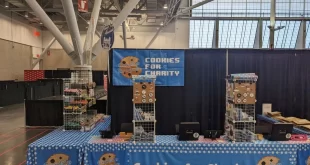The Nintendo Wii's unique control scheme and desire to inspire everyone from two to 200 to play on it has inspired its share of wacky, weird, and wonderful puzzlers and party games. One of the latest, Roogoo: Twisted Towers, is certainly a puzzler, possibly a party game, and unquestionably wacky and weird. Its wonderfulness however, is left in serious doubt.
The first of the Roogoo series to come to the Wii, Twisted Towers, has players spin platforms around so as to allow various shapes to fall into the appropriate hole in the tower – stars go into the star shaped holes, squares into the square shaped ones, etc. Perhaps the best way to think of it is as one of those toddler toys designed to teach shapes – the triangle only fits into the triangle shape, the circular only into the circle one – and to take that toy and stack it on another and another and another. The toddler would then have the triangle in the right place for the first toy, but have to shift around the second to allow the triangle continue on its way. Now, put space between the toddler toys, wire it in annoying fashion to a remote control, and obscure the toddler's point of view. Lastly, keep all the graphics very basic and blocky. That's Roogoo: Twisted Towers.
As the game progresses, the number of platforms increase as do the number of shapes and various obstacles on the platform which have to be overcome by shaking the Wii remote or pushing the down button or just waiting until enough pieces have stacked up. And then there's the net which is used for scooping up butterflies, bats, and dropped pieces (drop too many and one loses the level) and a hammer which comes into play on occasion for bonking baddies. There are some amusing boss battles as well, but the game never quite rises about ho-hum, and one definitely gets the sense that it could have. It fails though to ever be truly thrilling for several reasons.
The first of the issues is the game's insistence that only one platform can ever be rotated at a time. The player ends up feeling handicapped until the pieces fall through the platform. The game can be sped up when the platform is aligned correctly, but the shifting in speed up and then down again to adjust the next platform is awkward – however, if it's not done, players will forfeit their time bonus.
The next major problem with the game is the camera angles. The game is three dimensional, but the camera angle shifts automatically – when it's ready and in ways it wants to. All too often that means that as pieces fall the player can't quite make out where something is headed, a circle of light appears in the correct place on the platform the pieces are heading towards, which makes it easier. However, it isn't always present and it seems rather nonsensical to have to include a cheat like that when a better display would alleviate the need for one. The camera only gets worse when one progresses and the platforms go from being strictly vertical to being all over the place. The camera than swoops in and out and all around as it moves from one platform to another and as pieces are traveling (though the player can't always see them).
There is also a certain level of annoyance inherent in the control scheme. Platforms are rotated clockwise and counter-clockwise by pushing either the B or Z buttons respectively. As the analog stick never comes into play, one wonders why the movements cannot simply be mapped to it (push right for clockwise, left for counter) as the direction the platform turns may be more logical by doing that. The Wii Remote and Nunchuk can be held in either the right or left hand, so B and Z don't necessarily correspond to anything in terms of left and right, whereas the analog stick on the Nunchuk does. Then, trying to remember what drills, what speeds the pieces up, and what throws things becomes a lot to remember as there seems little logic behind the control scheme.
The monotony of twisting platforms is broken up with the occasional level in which your character skydives. He can then be moved in a circular fashion to pick up pieces while shooting the evil Meemoos, the minions of the evil Prince Moo, who, in traditional levels stand over holes in platforms and need to get bonked with pieces.
Because it's a Wii puzzler, the game also has several different multiplayer options. Two players can go through story mode together, with one player taking control of the hammer and net. There's a splitscreen two player race mode and a party mode for up to four, as well. The former allows for one player to attack another whereas in party, players take turns in controlling a platform (player one gets the first, two gets the second, etc.). There's some added value in the modes, but they don't overcome the overall issues the game contains.
Roogoo: Twisted Towers has all the elements a good puzzler should have – building huge stacks of shapes can be fun and moving the platforms so as to have items fall correctly and adding various traps and pitfalls along the way to make things that much more difficult are great building blocks on which to put a game. However, between a camera which hurts more than it helps, a control scheme which doesn't feel natural, and not giving the player full control of the platforms, the game simply has too many stumbling blocks to ever truly be enjoyable.
Roogoo: Twisted Towers is rated E (Everyone) by the ESRB for Mild Cartoon Violence.
 Blogcritics The critical lens on today's culture & entertainment
Blogcritics The critical lens on today's culture & entertainment



